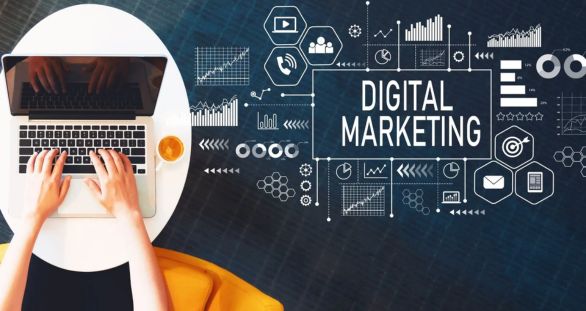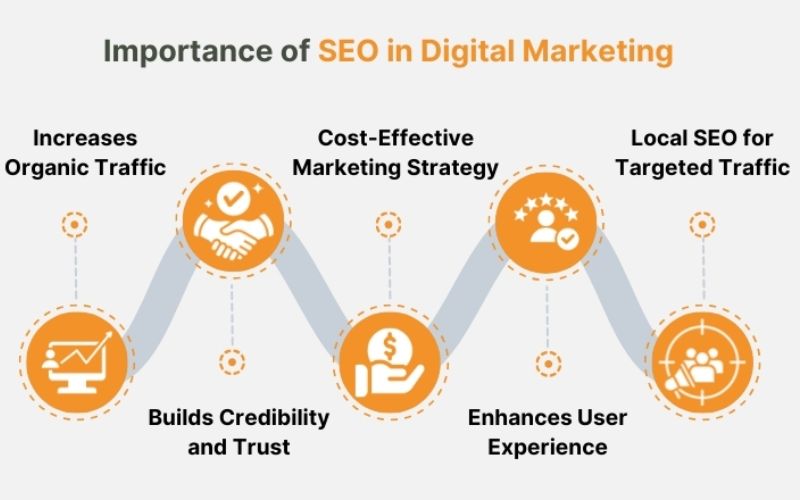What is Digital Marketing?
Digital marketing is the process of promoting products or services using digital channels such as websites, search engines, social media platforms, email, and mobile applications. Unlike traditional marketing, digital marketing lets businesses reach customers worldwide instantly, target specific audiences, and measure their results accurately.

Why Digital Marketing Matters
With more than half of the world’s population using the internet daily, digital marketing has become an essential way for businesses to connect with customers. It offers cost-effective advertising, instant communication, and the ability to adapt campaigns quickly based on real-time data.

Main Types of Digital Marketing
1. Search Engine Optimization (SEO)
SEO is the practice of optimizing your website to appear higher in search engine results when people search for relevant keywords. This helps increase free (organic) traffic to your site.
Example: If you run a bakery, SEO ensures your website appears at the top when someone searches “best birthday cakes near me.”
2. Content Marketing
Content marketing involves creating useful, interesting content like blogs, videos, or infographics to attract and engage your target audience.
Example: A fitness coach shares workout tips and healthy recipes through a blog to attract new clients.
3. Social Media Marketing
This type uses platforms like Facebook, Instagram, and LinkedIn to promote products and interact with customers. Businesses can post content and run targeted ads.
Example: A clothing brand runs Instagram ads showing their latest collection to fashion enthusiasts.
4. Pay-Per-Click Advertising (PPC)
PPC ads let you pay only when someone clicks on your advertisement. These ads commonly appear at the top of search results or social media feeds.
Example: An online tutor runs Google Ads and only pays when someone clicks and visits their site.
5. Email Marketing
Email marketing involves sending newsletters, promotional offers, or updates directly to people’s inboxes to build relationships and encourage purchases.
Example: An e-commerce store sends exclusive discount codes to customers on special occasions.
6. Affiliate Marketing
Affiliate marketing is when partners or influencers promote your product on their channels and earn a commission for every sale they generate.
Example: A tech blogger promotes a gadget and gets a small percentage when readers buy it via their affiliate link.
7. Influencer Marketing
Influencer marketing uses popular social media personalities to promote your brand and reach a larger, trusting audience.
Example: A beauty company works with a popular Instagram influencer who shares honest product reviews.
8. Online Advertising (Display Ads)
Display ads are images, videos, or interactive ads placed on websites and apps to attract visitors.
Example: A travel agency displays banner ads on popular news websites to promote holiday packages.
9. Mobile Marketing
Mobile marketing targets users on their phones via apps, text messages, or push notifications to promote products or offers.
Example: A food delivery app sends push notifications about discount offers to users.
10. Analytics and Data
Analytics tools collect data on your digital marketing campaigns, helping you understand what’s working and where to improve.
Example: Google Analytics tracks website visitor behavior and helps businesses make smarter marketing decisions.
Popular Digital Marketing Tools
To succeed, digital marketers use tools that simplify and improve their work. Some popular tools include:
- SEO: Google Search Console, Ahrefs, SEMrush
- Content Creation: Canva, Grammarly, BuzzSumo
- Social Media Management: Hootsuite, Buffer, Facebook Ads Manager
- PPC Advertising: Google Ads, Microsoft Advertising
- Email Marketing: Mailchimp, Sendinblue, Constant Contact
- Affiliate Marketing: ShareASale, CJ Affiliate
- Influencer Marketing: Upfluence, AspireIQ
- Display Ads: Google Display Network, AdRoll
- Mobile Marketing: OneSignal, Twilio
- Analytics: Google Analytics, Hotjar
Benefits of Digital Marketing
- Global Reach: Connect with customers anywhere in the world.
- Cost-Effective: Often cheaper than TV or print ads.
- Targeted Audience: Reach people based on age, interests, location, and more.
- Measurable Results: Track how many people saw and interacted with your ads.
- Flexibility: Change campaigns quickly if needed.
- Better Engagement: Interact directly with customers via social media and emails.
Conclusion
Digital marketing is no longer optional but necessary for businesses wanting to grow in the digital age. Understanding its types, tools, and benefits helps you create effective strategies to attract, engage, and convert customers online.